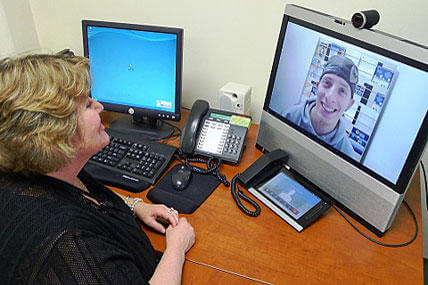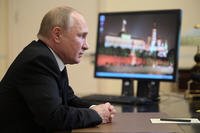The Department of Veterans Affairs on Tuesday showcased its “telehealth” system, a service designed to allow thousands of veterans from remote parts of the country to consult with specialists in medical facilities hundreds of miles away.
According to the VA, about 80,000 veterans took part in more than 200,000 telehealth consultations with doctors and therapists in 2012. The virtual appointments included vets receiving care and counseling for chronic medical conditions and for mental health counseling.
Dr. Robert Petzel, under secretary for health at the VA, said the virtual appointments are making a significant difference in the lives and health of patients. He told of one veteran who was driving 45 minutes in city traffic to keep in-person appointments with his mental health counselor.
“He would fight the traffic, be angry and upset by the time he got to see his therapist,” Petzel said. “And it would not be a particularly productive therapy session. He now participates in a tele-mental health program where he does his therapy from his home.”
“We’ve interviewed him. He points out the fact that now he’s relaxed, in an environment he’s comfortable in, he’s not upset about the traffic and he’s getting infinitely -- and he used the word infinitely -- more out of his therapy sessions now that he doesn’t have to travel that distance.”
On display at the event were various monitors that the VA is able to place in the homes of veteran patients to regularly monitor heart rate, blood pressure and more. Linked to a home computer, or even the telephone, data from the monitor is instantly transmitted to the veteran’s VA provider for review.
“[Telehealth] is really making our system much more accessible to veterans that have had difficulty in the past accessing it,” Petzel said.
Petzel also noted that the telehealth conferences, consultations and therapy sessions are not recorded and are not made part of a veteran’s health record. Any recording of a session would require the veteran’s written consent, he said.
The VA says the telehealth program has reduced veterans’ bed days by 58 percent and admissions by 38 percent.
The VA’s discussion and demonstration of the telehealth program was a rare public relations display by the department, which is more often in the news over a disability claims backlog that has seen some vets wait longer than a year for a decision.
But while the department, with its 152 medical centers and 14,400 outpatient clinics, has taken many a hit from Congress and some in the veterans’ community over the backlog, it has earned bragging rights for its telehealth program.
In June, the VA made the “2013 Most Wired” hospital system list, compiled by the Hospitals & Health Networks and based on a survey of 1,713 hospitals and health systems nationwide regarding their information technology initiatives
It was the first time in the 15-year history of the award that the VA made the list.
A VA official said today it began using telehealth about 12 years ago, though primarily to help patients monitor their medication.
Sen. Bernie Sanders, I-Vt., chairman of the Senate Veterans Affairs Committee, had nothing but praise for the telehealth program when he addressed the demonstration on Tuesday.
The VA is doing “cutting-edge work” in telehealth, Sanders said, “which the rest of the medical community around the country I think is going to learn from. … They are taking advantage of modern technology in a very aggressive way to improve high-quality and cost-effective health care to their patients.”






























